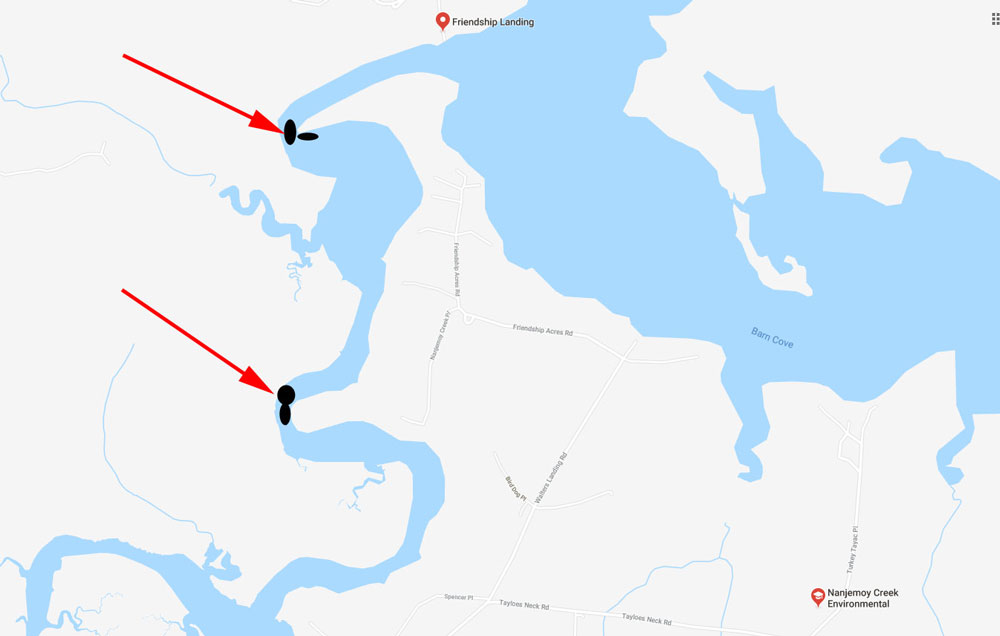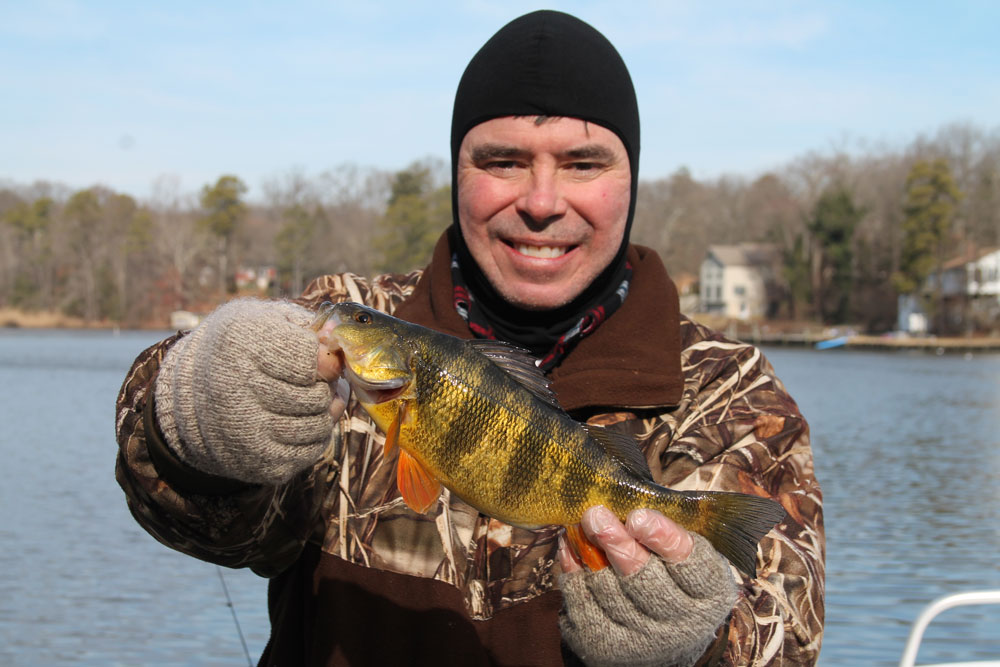You may have been keeping yourself occupied with catch and release fishing for trophy sized rockfish in warm water discharges, or maybe winter fishing for those big blue catfish has been how you're avoiding cabin fever, but many of us anglers are waiting for March when yellow perch start running up the rivers to spawn. That’s a darn shame, because by the time you start hearing that the perch are running, some of the best yellow ned fishing has already passed you by.

Tidal Creek Hotspots
Well before those perch even begin to think about spawning, they gather in pre-spawn areas to wait out the winter. In most tributaries up and down the Chesapeake as well as off the Delaware Bay, these pre-spawn hotspots are deep holes at the mouths of creeks. While most of the creek may be five, six, or 10 feet deep, holes that go beyond these depths and sometimes to 20 or even 30 feet will become packed tight with yellows beginning in January. Here they’ll stay until the first signs of spring send the fish up-river to the headwaters, where they’ll spawn.
Sharp bends in the shoreline often expose the likely areas. Let’s take a close-up look at Nanjemoy Creek off the Potomac River, in the graphic above, as an example. Remember that this is just one of dozens of creeks off the Potomac alone, but the basic concept of what we’re considering here remains the same whether you’re talking about any of the tidal creeks and rivers ranging from Watts Creek (off the Choptank River) to the Pamunkey (feeding the York River).
The black dots pointed to by the red arrows are extremely deep holes. The one you see at the top nears 30 feet, and the second one goes into the mid-20’s. Yet most of the surrounding areas are under 10 feet, and much of the stretch between the two holes is only a foot or two deep. In fact, I’ve run aground going from one to the other more than once. Both of these holes are deepest in the sharpest areas of the bends, and the drop-offs from the points sticking out into them are extremely abrupt. These are the spots where strong-running currents have, over time, scoured out the sediments that gather elsewhere and keep depths minimal. Yellow perch will begin trickling into these holes early in the winter, and usually provide steady fishing starting at some point in January. Often by February perch-jerking in these deep-water holes will be so fast and furious that at times you’ll envision the perch packed in there fin-to-fin. Remember, we’re just using this one creek as an example – the vast majority of the creeks with perch runs have similar holes in the bends which will hold those fish.
Fishing in the Snow
These perch will hit small jigs, shad darts, and countless similar offerings. Sweetening them with a minnow is usually a good move. Those who feel strongly about fishing with lures often cast 1/16th of an ounce jig heads with two- to three-inch tube jigs, shad tails, and similar soft plastics. But the best way to get the yellow perch onto the hook is a simple top-and-bottom rig with number four hooks, baited with lip-hooked bull minnow and fished dead on bottom. Remember that yellow perch are not shy about eating large minnow, and often the biggest bull minnow in the bait bucket is the best offering you can muster. Never shy away from one because it looks too big – it isn’t – and at times you’ll bait up with a giant four-inch bull minnow and reel in a six or seven inch overly-ambitious perch.

Grass shrimp work too and some people even favor them, but through the years you’ll discover that the majority of the time bull minnow can’t be beat. Note that this isn’t true later in the season, when the perch begin running up-stream. And the fish’s palette will divert towards shrimp even more when the whites begin their run, on the heels of the yellow perch. But for these mid-winter fish, you’re better off grabbing a bait bucket full of minnow.
Another oddity is that quite often, the perch will more readily take a minnow that’s just sitting there, as opposed to one being moved along. Casting out a couple of rods, sitting them down, and watching the tips for a jiggle may seem like lazy fishing, but it may also be the quickest way to success. That’s not to say you should never move the minnow, and on occasion crawling the bottom rig slowly up or down the edge of a hole triggers the strikes you’re waiting for. Try both and see what’s working best at any given time, but as a general rule of thumb, static baits will prove the winner.
Tidal Effects on Perch
There are, of course, exceptions to this rule, mostly relating to tide. As a general rule of thumb, fishing in these holes begins to get good when the tide is an outgoing, and is about half-way out. It gets better and better until the tide’s dead low. Then it often shuts down, sometimes like someone flipped the “off” switch, through the high tide. Arriving at your fishing spot at the very beginning of an incoming tide can make for a long, boring wait.
When the water is high you can, however, sometimes find some perch willing to bite up along the shorelines and over shallow flats that may have been exposed during low tide. This is particularly true over dark muddy bottoms on sunny days, when the rising water may be warmed a degree or two by the sunshine. In these areas bottom rigs will work but may become snagged in deadfall (which is relatively rare in the holes, by comparison to shallower areas), and quite often, switching over to a bobber rig is the smart move on high water. Try fishing minnow on a small shad dart, two to three feet beneath the bobber. Fishing it close to snags and structure is a good move, and when you get a bite stick with the area and work it hard because often the perch will gather tight to one particular tree, piling, or brushpile.

Another option provided by a high tide is the ability to run farther up the creek, and look for crappie. When you get to the upper reaches of most of these tidal creeks you’ll discover that crappie are often hiding amongst trees, beaver dams, or docks near shore. Largemouth bass and in some areas pickerel are often an interesting by-catch. Remember, however, that in tidal waters the fish often gather in one very specific area. A hundred yards of shoreline may be covered in downed trees, yet only one of those trees holds all of the fish. Stay on the move and cover a lot of territory, until you start getting bites.
Another option is to carry some cut bait, and when the perch aren’t in feeding mode, let it sit on bottom for catfish – another common inhabitant of these areas. Anything from frozen shad to chicken livers will get them on the line, especially when you can locate a snag or obstruction sitting on bottom in one of those holes.
Sure, it’s the spring run of perch that grabs the headlines. Yes, you will have to bundle up a bit more to get in on this mid-winter action. But the countless tidal creeks and rivers running into the bays from Delaware down to Virginia give Mid-Atlantic anglers a fantastic fishing opportunity, even when it’s snowing – all you have to do is find those holes.
Sign up here to get the weekly FishTalk Chesapeake Bay and Mid-Atlantic fishing reports in your email inbox, every Friday by noon.